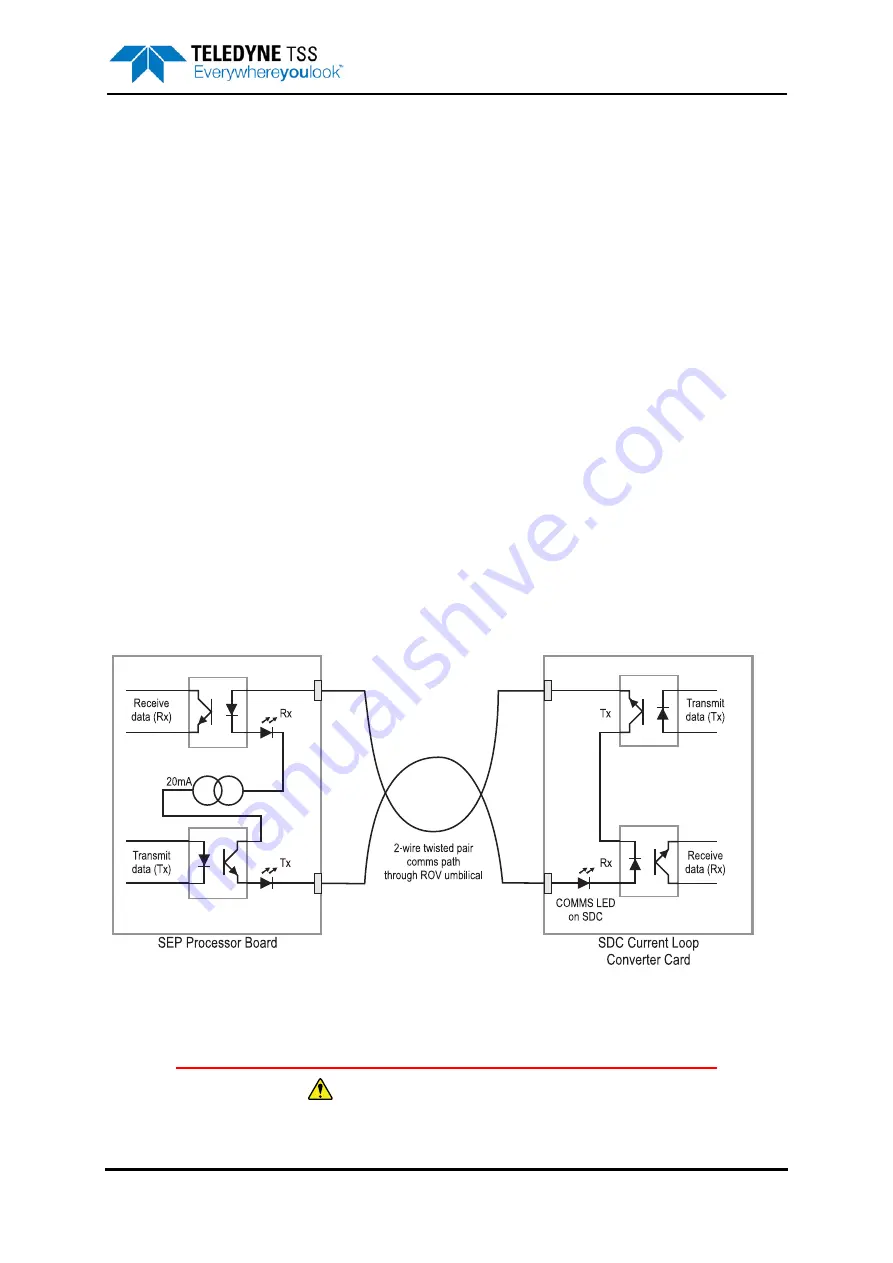
9 – Maintenance
DPN 402196 Issue 4.1
© Teledyne TSS
9- 5
After the initial 250V spike, the signal returned from the search-coil represents the voltage induced in
the target by the original current pulse.
The Analogue Board applies two stages of pre-amplification to each signal channel with an overall gain
of 200. If the SEP receives a signal that is too strong, the DSP removes the second stage of
amplification to reduce the overall gain to 10.
The Analogue Board removes noise using an intelligent filter that clamps the signal to zero until the
end of the 250V spike.
The conditioned signal then passes to the Main Board for processing and analysis.
9.1.3 Communications Loop
When you configure the System to use the 2-wire current-loop communications method, the SEP and
the SDC share a twisted pair in the umbilical. To avoid possible contention, the 440 System assigns
‘Master’ status to the SDC, and ‘Slave’ status to the SEP.
Immediately after you power-on the 440 System, the SEP transmits a short ‘banner’ message to the
SDC and then waits for commands to arrive. Other than its initial banner message, the SEP will not
transmit any data until it receives a carriage-return signal from the SDC.
The SEP Main Board generates current at 20mA for the communication loop. The ‘COMMS’ LED on
the SDC is in series with the current-loop and therefore confirms that the communication loop is intact
when it shows red. Note that the COMMS LED does NOT confirm successful communication between
the SEP and SDC, but shows only that the loop is intact.
Figure 9-3 shows a simplified schematic of the current-loop, including the optically isolated I/O ports at
both ends of the umbilical cable.
Figure 9-3: Simplified schematic of the current-loop
9.2 Disassembly and Reassembly
WARNING - ELECTRICAL HAZARD
Mains power supply voltages can cause death or serious injury by electric shock.
Summary of Contents for 440
Page 12: ...List of Figures x Teledyne TSS DPN 402196 Issue 4 1 ...
Page 18: ...Glossary xvi Teledyne TSS DPN 402196 Issue 4 1 ...
Page 24: ...1 Introduction 1 6 Teledyne TSS DPN 402196 Issue 4 1 ...
Page 32: ...2 System Overview 2 8 Teledyne TSS DPN 402196 Issue 4 1 ...
Page 66: ...4 Electrical Installation 4 20 Teledyne TSS DPN 402196 Issue 4 1 ...
Page 88: ...5 Operating Software 5 22 Teledyne TSS DPN 402196 Issue 4 1 Figure 5 10 Altimeter Test ...
Page 144: ...6 Operating Procedure 6 40 Teledyne TSS DPN 402196 Issue 4 1 ...
Page 154: ...7 Operational Considerations 7 10 Teledyne TSS DPN 402196 Issue 4 1 ...
Page 164: ...8 System Specifications 8 10 Teledyne TSS DPN 402196 Issue 4 1 ...
Page 203: ...10 System Drawings DPN 402196 Issue 4 1 Teledyne TSS 10 17 Figure 10 15 SDC10 Dimensions ...
Page 230: ...A Operating Theory A 12 Teledyne TSS DPN 402196 Issue 4 1 ...
Page 242: ...B Options B 12 Teledyne TSS DPN 402196 Issue 4 1 ...
Page 244: ...C Altimeter C 2 Teledyne TSS DPN 402196 Issue 4 1 ...
Page 246: ...D Reference D 2 Teledyne TSS DPN 402196 Issue 4 1 ...
Page 248: ...D Reference D 4 Teledyne TSS DPN 402196 Issue 4 1 ...
Page 250: ...D Reference D 6 Teledyne TSS DPN 402196 Issue 4 1 ...
Page 252: ...D Reference D 8 Teledyne TSS DPN 402196 Issue 4 1 ...
Page 254: ...D Reference D 10 Teledyne TSS DPN 402196 Issue 4 1 ...






























